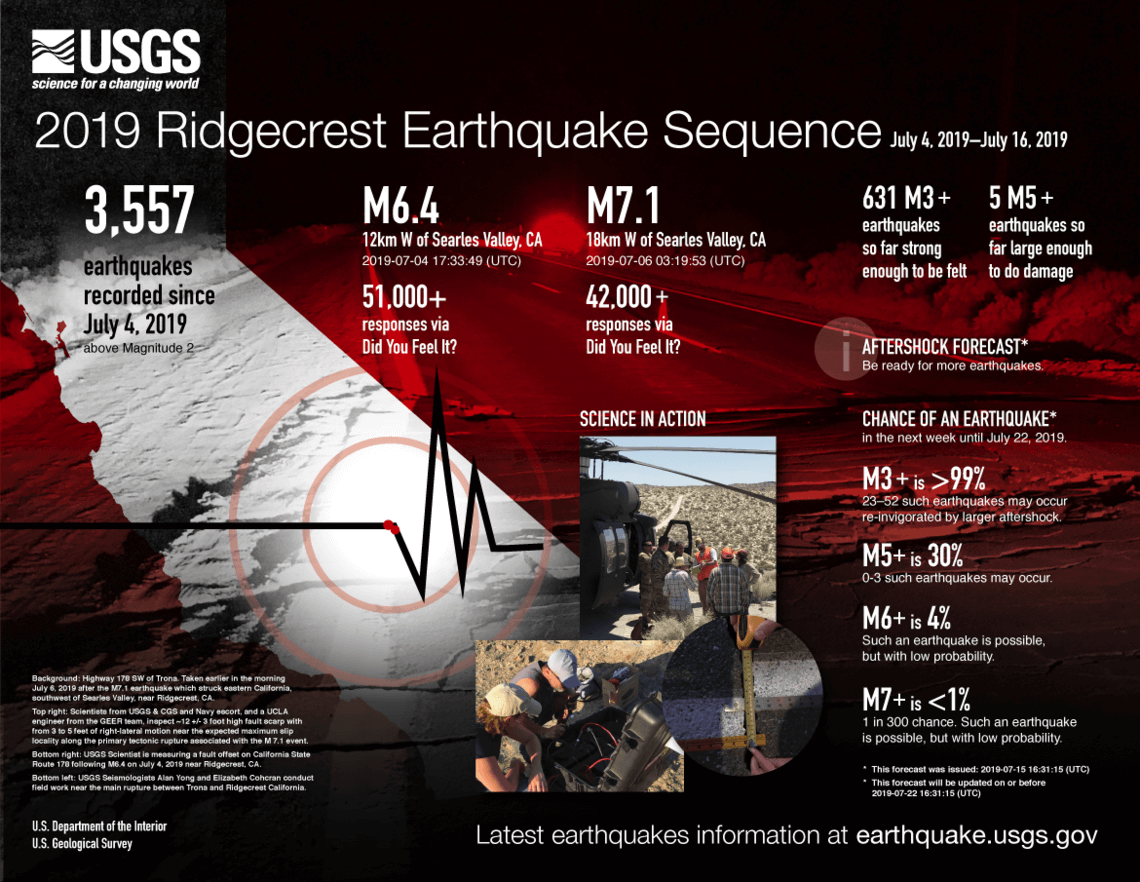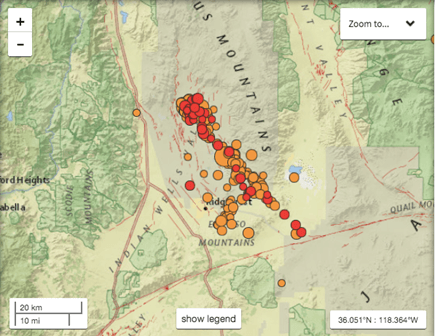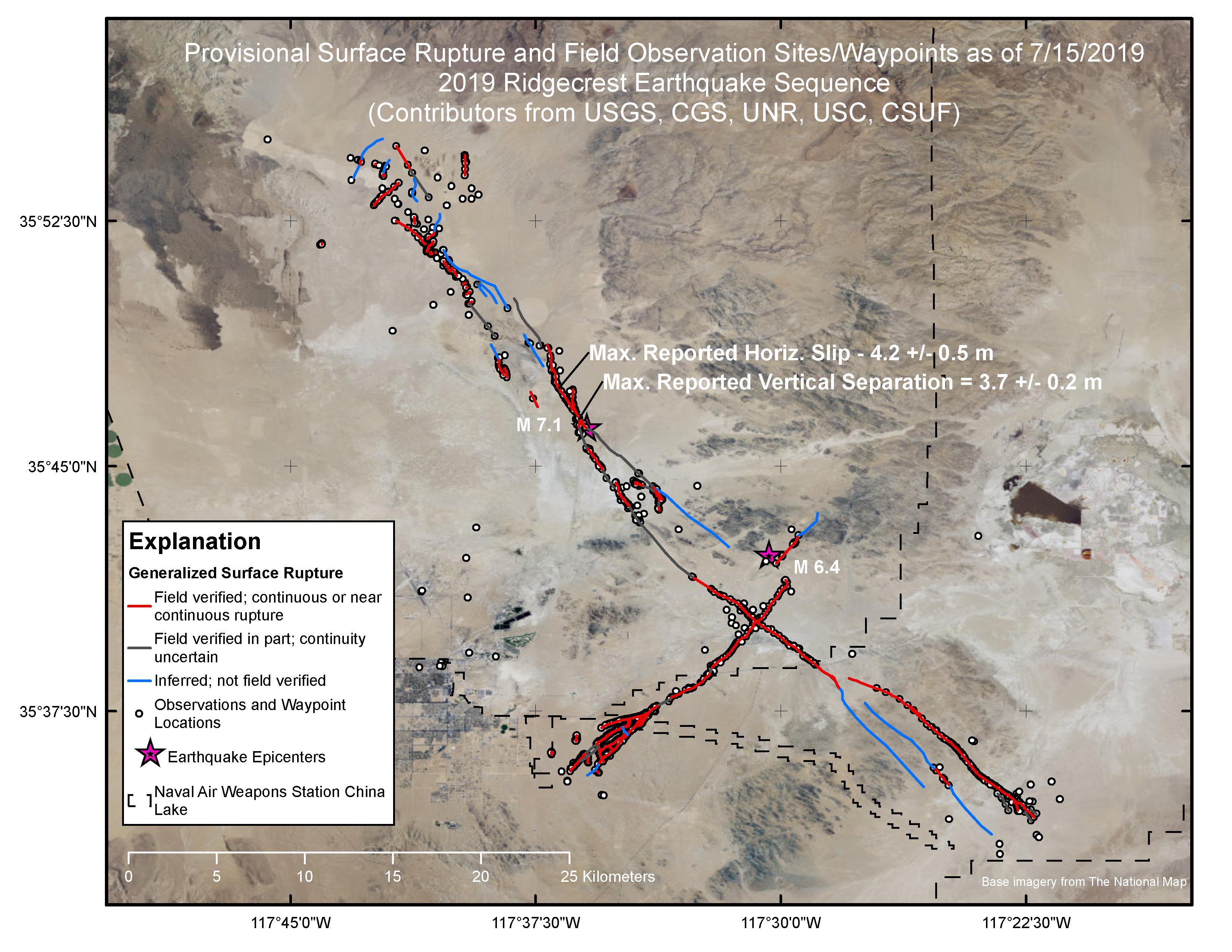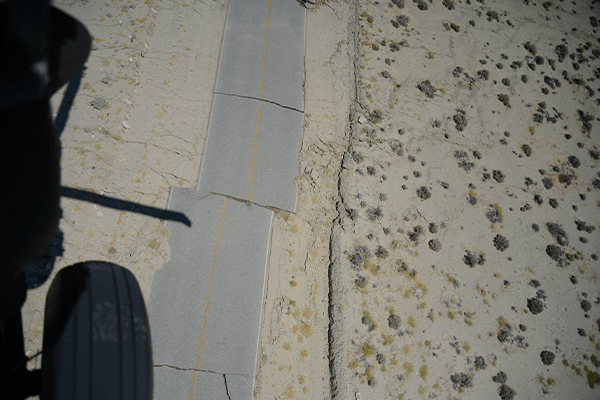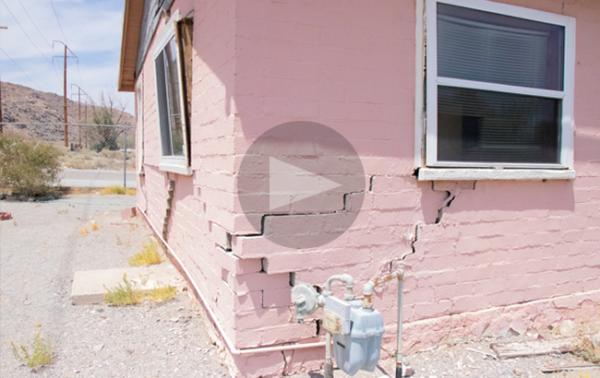California Shaken: Ridgecrest Earthquakes Unleashed Devastating Power
The July 2019 Ridgecrest Earthquakes were California's biggest in more than 20 years. On Thursday, July 4th, at 10:33 a.m. PST a magnitude 6.4 earthquake struck about 12 kilometers (10.5 miles) southwest of Searles Valley. Multiple aftershocks followed, and on Friday, July 5th, another earthquake struck with a magnitude of 7.1.
The July 5, 2019 magnitude 7.1 earthquake which ruptured the earth in the Mojave Desert unleashed the power of 45 nuclear bombs. The earthquake's power was similar to the bomb that fell on Hiroshima.
The July 2019 Ridgecrest Earthquake Sequence
Earthquakes are not isolated events. There have been 3,557 earthquakes since July 4 in Ridgecrest/Searles Valley. These sequences are often dominated by an earthquake with a larger magnitude than all others in the sequence. Much of downtown Los Angeles felt the larger 7.1 earthquake on July 5. People felt it as far away as Sacramento, San Diego and Las Vegas.
Ridgecrest Earthquake Map
California is seismically active because it sits on the boundary of two giant tectonic plates, the Pacific and North American. Earthquakes happen as the southwestern side of California slides up northwestward toward Alaska, compared to its northeastern half. Though much of that motion results in earthquakes along the San Andreas fault, the seismic stresses are also relieved on other fault strands, including those in the Eastern California Shear Zone which includes Searles Valley and Ridgecrest.
The July Ridgecrest earthquakes occurred on a vertical fault whose northwest-southeast direction drove the intense shaking away from more populated areas. The epicenter occurred just south of the China Basin Naval Air Weapons Center.
Surface Ruptures from the July 4 and 5 Ridgecrest, CA Earthquakes
Assessing the Damage and Impact of the 2019 Ridgecrest Earthquakes
Damage estimates for the Ridgecrest earthquakes top $1 billion according to U.S. Geological Survey. The earthquakes jolted the Kern County community of Ridgecrest, where most of the temblors were centered, and the city of Trona in San Bernardino County. Big stretches of Highway 178 were left visibly cracked.
Mobilehomes were torn off foundations, chimneys fell, gas lines leaked and some homes caught fire. Residents of Trona were without water service for four days.
While there were areas in Kern County and San Bernardino County that felt very strong to severe shaking, the majority of homes remained in fairly good shape following the back-to-back earthquakes.
Why Some Structures Withstood the Ridgecrest Quakes
Why was the damage relatively minor for most homes? The area homes are relatively new, one or two story, and built with the types of materials that make them more resilient to earthquakes. Had the epicenters been near bigger cities with less resilient buildings, quakes of these magnitudes would have been devastating.
The Impact of the Ridgecrest Earthquake: Aftermath and Devastation
Although it is true that it could have been much worse, we cannot overlook the devastation that these large events caused. In SoCal, people have had to move out of their homes due to earthquake damage, and many had to live in shelters.
For more evidence on how Ridgecrest rocked the area, check out interesting videos and GIFs of the displacement and ground movement.
Lessons Learned from the Ridgecrest Earthquakes
California is earthquake country. With nearly 16,000 known faults, each region of the state holds earthquake risk. Most of us live within 30 miles of an active fault.
Building Smart, Staying Safe: Ridgecrest Earthquakes Reveal Earthquake-Resistant Home Benefits
Residents of Ridgecrest owned homes that were built after 1990 and were made of materials that were more resistant to earthquakes. CEA was on the ground in Ridgecrest and Trona on July 5. More than 20% of Ridgecrest homeowners carried CEA earthquake insurance which helped them with emergency repairs and covered emergency housing when they lost the use of their homes.
The violent shaking from earthquakes can rupture the earth triggering landslides and turning the surface of the earth to liquid. Your home also may be vulnerable to serious structural damage if it was built before 1980.
What to do During an Earthquake
Despite living in earthquake country, many people are not prepared for earthquakes. In the days following the first Ridgecrest earthquake, there was a lot of misinformation on how to best survive a big earthquake. For example, doorways and bathtubs are NOT the safest places!
In the event of an earthquake, practice Drop, Cover, and Hold On:
- Drop to the ground; get under a sturdy piece of furniture like a table or desk.
- Cover your head and neck.
- Hold on until the shaking stops. Injuries occur when people move from safe locations.
Visit our page on the Seven Steps to Earthquake Safety.
Be Informed, Buy the Right Earthquake Insurance Coverage
When the back-to-back Ridgecrest earthquakes hit, several fires started, mobilehomes fell off their foundations, and there were breaks in water mains. Some thousands of smaller earthquakes were felt in the following weeks in the communities of Trona and Ridgecrest.
Despite the record number of earthquakes that hit California, California’s Department of Insurance states that only about thirteen percent of Californians statewide are prepared with earthquake insurance.
CEA affordable and flexible home earthquake policies:
- Offer choices of coverage and deductibles.
- Protect the investment in your home.
- Provide you with peace of mind when, not if, the big one hits.
Whether you are a homeowner, mobilehome owner, condo-unit owner or renter, find out about how to buy the best choices in earthquake insurance. Home insurance policies and tenant insurance don't include earthquake coverage. The homeowner or renter needs a separate or companion earthquake policy to cover damages from an earthquake. Find out why over one million California households are covered by CEA earthquake insurance.
Get started today with an estimate.
Common Questions After Ridgecrest
Get answers to frequent questions such as how to buy earthquake insurance after an earthquake, where to buy, and how our coverage options work.
A. You can buy a CEA earthquake insurance policy through one of CEA's participating residential insurance companies. CEA does not offer stand-alone policies. Learn more about how to buy a CEA earthquake insurance policy.
A. The cost of your policy depends on many factors such as the earthquake risk where you live, the age and characteristics of your home, and the coverages and deductibles you choose. CEA offers several coverage choices as well as a number of deductible options to help you find a policy that best meets your needs and budget. Use our Premium Calculator to estimate the cost of your earthquake insurance policy.
A. You do not pay your deductible out-of-pocket. The deductible is subtracted from your covered damage so you don’t have to pay any of the deductible up front to receive a claim payment.
A. If you purchased Loss of Use coverage, you are eligible to receive payment for the additional living expenses necessary to maintain your normal standard of living, up to the coverage limit you selected. Remember that Loss of Use coverage never has a deductible!

